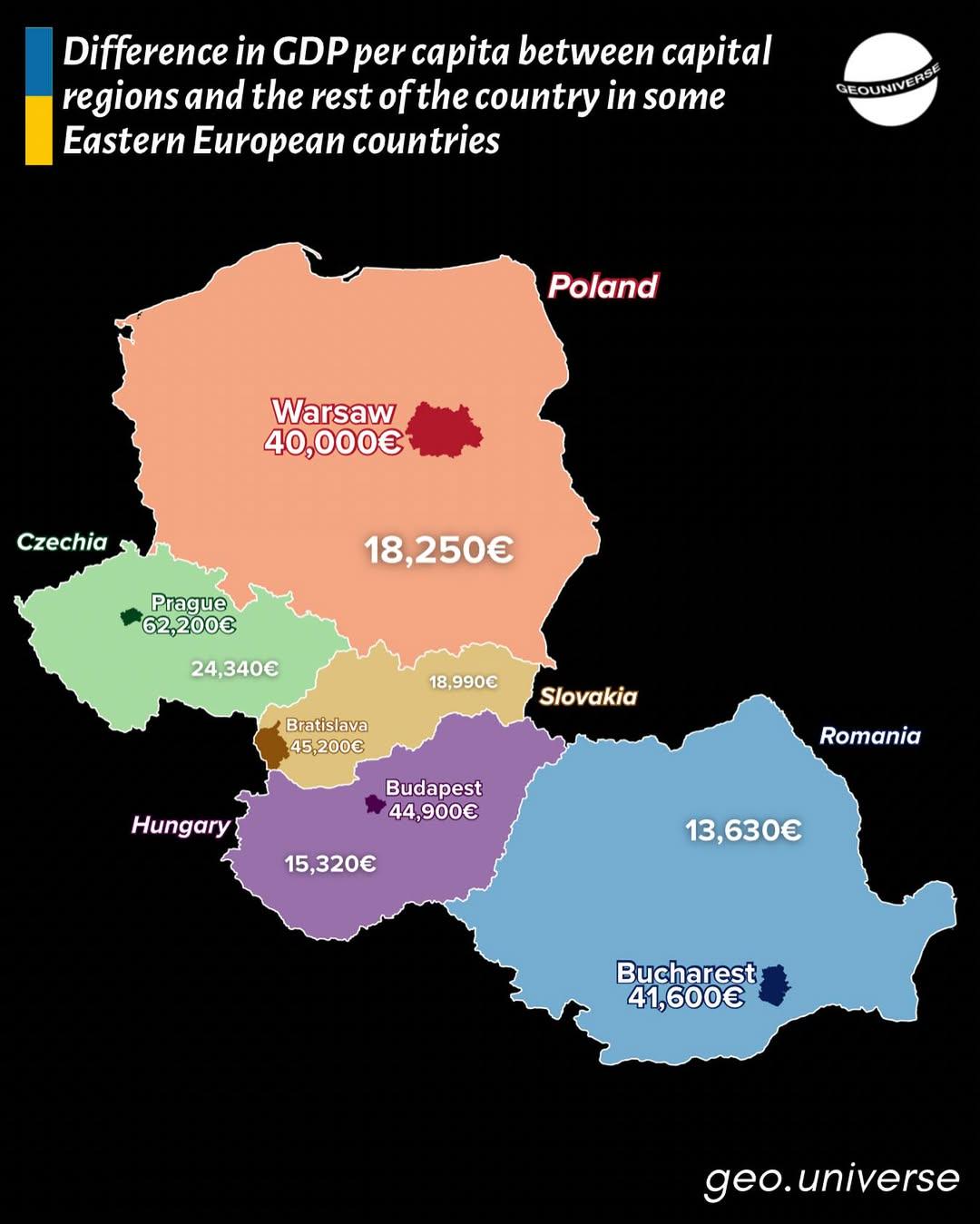GDP Per Capita Gap Map in Eastern Europe


Marcus Rodriguez
Historical Geography Expert
Marcus Rodriguez specializes in historical cartography and geographic data analysis. With a background in both history and geography, he brings unique...
Geographic Analysis
What This Map Shows
This map visually illustrates the disparities in GDP per capita between capital regions and the rest of their respective countries in several Eastern European nations. By highlighting these gaps, the visualization underscores the economic polarization that often exists within these countries, where capital cities frequently enjoy significantly higher economic prosperity than their rural counterparts.
When we look at GDP (Gross Domestic Product) per capita, we are essentially measuring the economic output per person, providing a clear picture of the economic health and living standards of a population. In the context of Eastern Europe, this map serves as a critical tool for understanding economic inequalities that can influence a country's social fabric and development trajectory.
Deep Dive into Economic Disparities
The significant differences in GDP per capita between capital cities and other regions are not unique to Eastern Europe; however, they are particularly pronounced in this region due to historical, political, and economic factors. Capitals like Warsaw, Budapest, and Prague often serve as economic powerhouses, attracting investment, infrastructure development, and skilled labor. For instance, Warsaw's GDP per capita is significantly higher than that of the Mazovia Voivodeship, primarily due to its concentration of businesses and services, which are less prevalent in rural areas.
Interestingly, these disparities can be traced back to the economic policies of the past. Post-communist transitions have often led to a concentration of wealth in urban centers, as these areas are better equipped to adapt to market economies. The capital regions benefit from better access to education, healthcare, and employment opportunities, which, in turn, attract more people seeking a higher quality of life.
Moreover, the map reveals that in some countries, the gap can be staggering. For example, in Bulgaria, Sofia's GDP per capita is markedly higher compared to the national average, reflecting a trend where people flock to the city in search of better economic prospects.
This economic polarization can also lead to regional neglect, where less developed areas struggle to attract investment or retain talent. Have you noticed that rural areas often face challenges such as declining populations and limited job opportunities? These factors further exacerbate the gap, creating a cycle of disadvantage that can be difficult to break.
Regional Analysis
Looking at specific regions on the map, we can identify distinct patterns. In Poland, for example, the GDP per capita in Warsaw is nearly double that of smaller cities like Lublin or Radom. This trend is mirrored in Hungary, where Budapest's robust economy contrasts sharply with the more modest outputs of towns like Szeged or Debrecen.
In the Baltic states, cities like Tallinn and Vilnius are similarly thriving compared to the rest of Estonia and Lithuania, respectively. Interestingly, Estonia has made significant strides in technology and innovation, positioning Tallinn as a startup hub, which further inflates its GDP figures compared to rural areas.
In contrast, countries like Romania present a mixed picture. Bucharest exhibits a high GDP per capita, but regions in Transylvania or Moldova often lag significantly behind, highlighting the uneven development that can exist even within the same country.
Significance and Impact
Understanding the GDP per capita gaps between capital regions and the rest of the country is crucial for several reasons. Economically, it prompts policymakers to consider strategies to stimulate growth in underperforming areas. The persistence of these disparities can lead to increased social tensions, as those in economically disadvantaged regions may feel left behind in a rapidly changing world.
Moreover, these economic divides have real-world implications for migration patterns within these countries. As people move to capitals in search of better opportunities, rural areas may suffer from population decline, leading to an aging demographic and reduced economic activity.
Looking to the future, addressing these gaps is vital for sustainable development. Countries must find ways to distribute economic opportunities more evenly to foster balanced growth and social cohesion. The map serves as a vital reminder of the work still needed to bridge these divides and create a more equitable economic landscape in Eastern Europe.
Visualization Details
- Published
- September 11, 2025
- Views
- 86
Comments
Loading comments...